The Shining
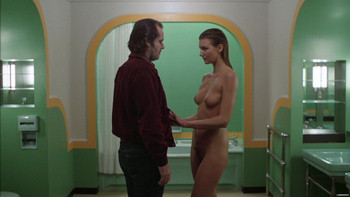
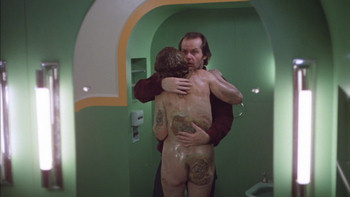
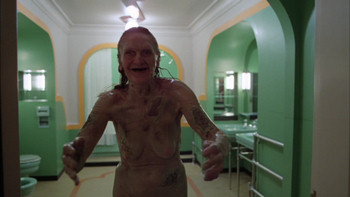
It’s not your typical turning point. A heretofore pedestrian movie doesn’t begin to redeem itself, and a previously engaging work doesn’t go off the rails.
Instead, things start to get muddled. The movie becomes instantly less creepy – actually uncreepy in my eyes. The horror turns mundane. As Jack goes insane – or more insane, as Jack Nicholson’s performance starts somewhere south of healthy – the casual, drunken violence of his past floods out furiously, dammed up for too long. It becomes clear that an abusive husband and father poses a graver physical danger than the ghosts of the Overlook Hotel.
More importantly, this juncture befuddles the audience’s understanding of the supernatural elements – a confusion that’s reinforced as the story progresses. And most critically, it expands the film’s scope from a haunted-hotel and haunted-child narrative to something messier and richer. So while provocative close readings can be enlightening, with The Shining they feel more amusing than correct. The movie works precisely because it’s slippery, and attempts to explicate the paranormal core ignore its design.
I haven’t read the Stephen King novel on which Stanley Kubrick’s 1980 film was based, but I saw enough of the reportedly faithful 1997 miniseries that King wrote and executive-produced to understand that they’re distinct. And I believe that the negative reaction of many King fans to Kubrick’s movie is directly related to its unresolvable character – that the nature of the horror, and the motivations of the ghosts, cannot be neatly explained.
Similar to No Country for Old Men and Psycho, The Shining uses subversive shock to repel analysis in the moment; the movies establish expectations and then crush them, and the audience is left struggling to find its bearings. But in those two examples, the act is literally violent: The ostensible protagonist is killed long before the movie ends, and viewers know they’ve been set adrift.
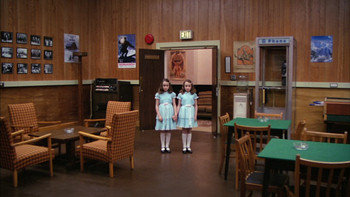
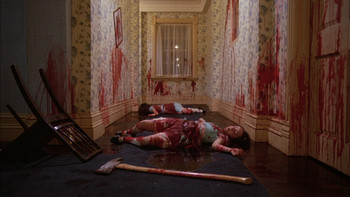
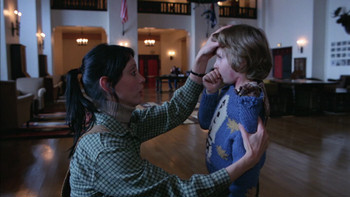
The Shining is more sly. Kubrick’s frequent dead-center, symmetrical compositions are subtly but viscerally disturbing, and his musical choices tap into unease, starting with the synthesized, droning melody of the opening-credits theme. The vivid, indelible supernatural visions by Danny give way to an amorphous, almost comic spook show – epitomized by the cackling naked corpse.
While most horror tales establish mysteries and move toward ordered resolution, Jack’s Room 237 encounter signals a shift toward entropy, and the movie never looks back. In a broad sense, The Shining works in the same way as Picnic at Hanging Rock and The Mothman Prophecies: At the end, you’re still not sure what forces you’ve been experiencing.
Where The Shining differs is that, at the outset, you think you know. As it’s explained to Jack during his job interview at the Overlook, one winter caretaker went nuts and axed his wife and two daughters. Those two girls – with their sunken eyes, in their matching baby-blue dresses tied with pink ribbons around the waist – are the audience’s first evidence that something is not right. As the hotel’s cook tells Danny:
“When something happens it can leave a trace of itself behind – say like if someone burns toast.”
Yet only Danny sees those girls, and from the beginning we’re led to believe that the child’s “shining” ability allows him to experience things his parents cannot. When Jack enters Room 237, though, that changes. Of course, Jack’s alcoholic fantasies can be explained by his mental state.
What cannot be dismissed comes more than two hours into the movie, in a sequence of such climactic tension that it barely registers. With Jack on a murderous rampage, a panicked Wendy interrupts a spectral tryst between two men, one of them in a bear (or dog?) suit.
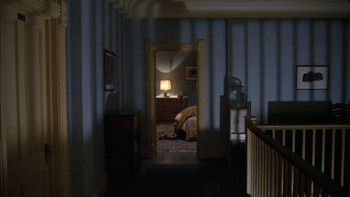
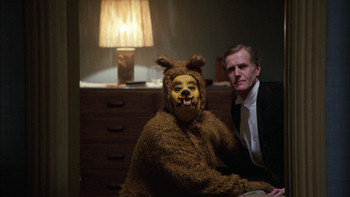
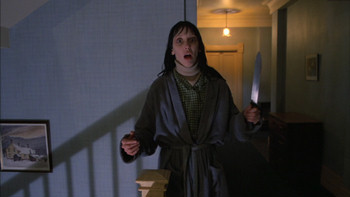
The man in the costume – with its ass-hatch open – is clearly servicing the man in formal wear, and after noticing her, they look at her with a detached bemusement.
Wendy reacts with visible horror, but it’s obvious that she is incapable of processing what she’s seeing – as is the audience.
Wendy – with Shelley Duvall’s overbite and homeliness as fantastic props – is the person in whom the audience invests its empathy, not because we relate to her as an individual but because she’s the only “normal” person at the Overlook. She doesn’t see what Danny and Jack see, and she gives the audience hope that a blindness to the supernatural might have some power over the supernatural, that it might keep it at bay. Danny is told that these things he sees from the past can’t hurt him, and in the end it feels like wishful thinking, but Wendy seemed genuinely immune to the paranormal horrors of the Overlook.
When she glimpses those two men, it’s a deeply unsettling moment, because the rules of the game are different from what we thought.
Danny’s visions are tightly circumscribed – limited to the butchering of a single family and rooted in his ability to “shine.” Jack’s seem tied to his brethren among the hotel help, and their purpose is transparent: They need him to do their bidding.
But what Wendy sees is horrifying because it conforms to nothing. It is neither menacing nor violent, and there is no easy understanding or satisfying accounting; it is simply aggressively odd, underscored by the costume and italicized by the homosexuality that we expect is foreign to simple Wendy.
That ghostly moment is fleeting but major, the key to The Shining. Instead
of unlocking the movie, though, it ensures that it remains shut and enigmatic.
For ever, and ever, and ever … .
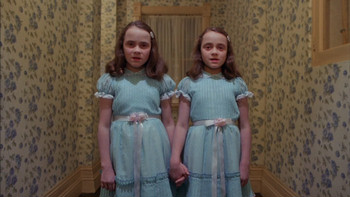


What kind of self-proclaimed culture snob doesn’t read the book that the movie is based on? At any rate, I think the ‘provocative close reading’ of the Shining which you disparage is far more interesting (and no less amusing) than your own.
hmmm: Me, apparently. And can’t we consider them separately?
As for the “close reading” I noted, I didn’t disparage it all, and do not dispute that it is far more interesting and amusing than mine. I just think it’s a major stretch.
I was there.
We watched the Shining for the umpteenth time today, as Kubrick is one of hubby’s favorite directors. We wind up playing MST3K with the movie, with every scene providing us with lines, some new, some old.
But when we hit the guy in what I thought was a rat costume, with the guy in the evening jacket – we always just stop, look at each other and try to figure out what’s going on, as this breaks the flow of the movie.
Thank you, now I know why.